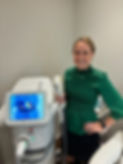What is Dry Eye?
Dry Eye Symptoms
Dry eye can manifest in a variety of ways, making it challenging to pinpoint the root cause of your discomfort. Common symptoms include burning, redness, a foreign body sensation, mild to moderate blurry vision, fluctuations in visual clarity, excessive tearing, or an overall feeling of dryness.
These symptoms are often triggered or worsened by environmental factors like smoke, wind, heat, or low humidity, as well as activities that require prolonged focus, such as computer use. Many people find that their symptoms become more pronounced later in the day due to eye strain and exposure.
If you’re experiencing any of these symptoms, you’re not alone. Schedule a consultation today to explore a personalized approach to managing dry eye.
What Causes Dry Eye?
Dry eye is a complex condition, and understanding its underlying cause is essential for effective treatment. Two common types are evaporative dry eye and inflammatory dry eye, each with unique characteristics:
Evaporative Dry Eye
This occurs when the tears evaporate too quickly due to an imbalance in the tear film’s lipid layer. The lipid layer, produced by the meibomian glands in the eyelids, is crucial for stabilizing tears and preventing evaporation.
• Common Causes: Meibomian gland dysfunction (MGD), clogged glands, or environmental factors like wind or low humidity.
Aqueous Deficient Dry Eye
This type is linked to inflammation of the ocular surface, tear glands, or eyelids, which disrupts tear production and quality. Chronic inflammation can lead to a lack of lubrication, damaging the eyes over time.
• Common Causes: Autoimmune conditions (e.g., Sjögren’s syndrome), allergies, or underlying systemic inflammation.
How Do I Know If I Have Dry Eye?
At your dry eye evaluation, Dr. Jahnke will take a personalized approach to identify the cause of your symptoms and create a treatment plan tailored to your needs.
What to Expect
1. Comprehensive Assessment
Your visit begins with a detailed discussion of your symptoms, followed by a thorough eye exam using:
• Fluorescein Stain: To evaluate tear stability and break-up time.
• Lissimine Green Stain: To assess the cornea and conjunctiva for irritation or damage.
2. Advanced Diagnostics
We use cutting-edge imaging to analyze meibomian gland function and determine the type of dry eye you have—whether evaporative, aqueous deficient, or both. We will use your dry eye report to deisgn a specific treatment plan for you symptoms.
3. Customized Treatment
Dr. Jahnke will design a treatment plan based on your specific needs, which may include: Over-the-counter lubricants, prescription drops or in office therapy.
4. Ongoing Care
Dry eye requires ongoing management. Dr. Jahnke will monitor your progress to ensure lasting relief and comfort.
New Advances in Dry Eye Treatments
Understanding Your Dry Eye Type
While some individuals may have one dominant type, others may experience a combination of evaporative and inflammatory dry eye. Identifying the root cause is the first step toward finding relief. Treatments may include:
• For Evaporative Dry Eye: Warm compresses, meibomian gland expression, or lipid-based artificial tears; like Meibo, an FDA-approved prescription eye drop specifically designed to treat evaporative dry eye. Avenova is an eye spray designed to help manage meibomian gland dysfunction by reducing the bacterial overgrowth that can contribute to the clogging of the glands.
• For Aqueous Deficient (Inflammatory) Dry Eye: Prescription anti-inflammatory drops; like Xiidra and Cequa, lifestyle changes, or systemic treatments for underlying conditions. IPL (Intense Pulse Light) Therapy can help in reducing inflammation, improve meibomian gland function and reduce Demodex mites that can cause redness and itching along the lid margin to improve the overall comfort of the eyes and improve tear production and quality.
If you’re unsure about the type of dry eye you’re experiencing, we can help. Schedule a comprehensive dry eye evaluation to develop a treatment plan tailored to your needs.






